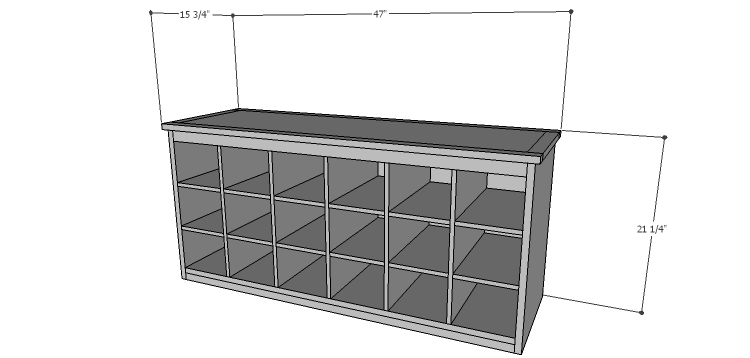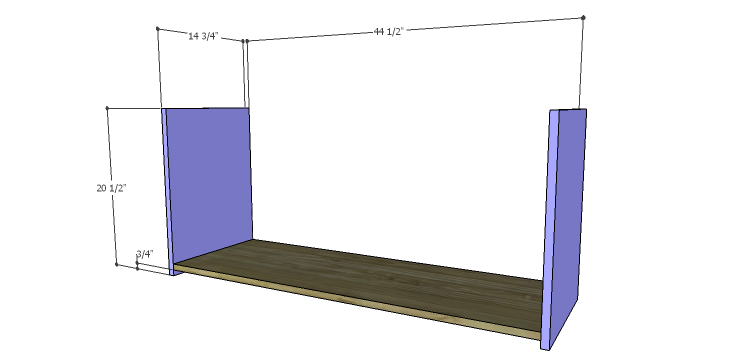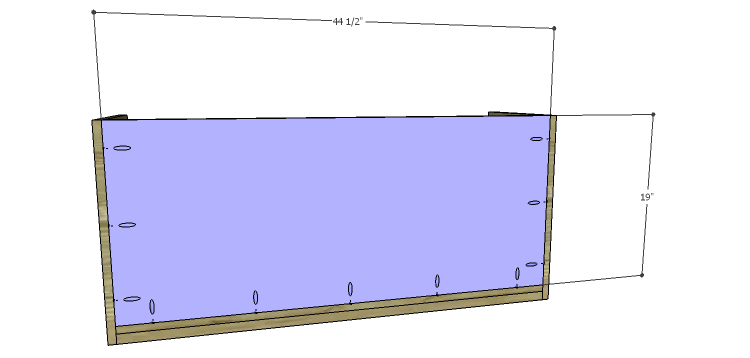DIY Plans to Build a Maxwell Shoe Storage Bench
An Excellent Bench with Built-In Storage
Tired of the mudroom or entryway being a huge mess with piles of shoes and umbrellas? The DIY plans to build a Maxwell Shoe Storage Bench can help solve that problem! Featuring eighteen cubbies, the bench is the ultimate in shoe and umbrella storage, and would be an excellent place to stash pet leashes or a few hat and scarf sets!

Materials:
- 1-1/4″ pocket hole screws (<– affiliate link!)
- 1-3/4″ brad nails
- Edge banding, optional
- Wood glue
- Sandpaper (100, 150, 220 grits)
- Finishing supplies (primer & paint, or stain, sealer)
Lumber:
- 3 – 1×2 at 4′
- 2 – 1×2 at 6′
- 1 – 4′ x 8′ sheet of 1/2″ plywood
- 1 – 4′ x 8′ sheet of 3/4″ plywood
Cut List:
- 2 – 3/4″ plywood at 14-3/4″ x 20-1/2″ – Sides
- 1 – 3/4″ plywood at 14-3/4″ x 44-1/2″ – Bottom
- 3 – 1×2 at 44-1/2″ – Bottom Stretcher & Upper Stretcher
- 1 – 3/4″ plywood at 19″ x 44-1/2″ – Back
- 5 – 1/2″ plywood at 14″ x 19″ – Cubby Dividers
- 2 – 1/2″ plywood at 14″ x 44-1/2″ – Cubby Dividers
- 1 – 3/4″ plywood at 12-3/4″ x 44″ – Top Panel
- 2 – 1×2 at 12-3/4″ – Top Side Trim
- 2 – 1×2 at 47″ – Top Front & Back Trim

Click on the drawings for a larger view!
Step One
Edge banding will be applied to the exposed edges of the plywood prior to assembly!
Cut the pieces for the sides and the bottom. With the pocket hole jig set for 3/4″ material, drill pocket holes in each end of the bottom piece. Position the bottom 3/4″ up from the lower edge of the sides then secure in place using glue and 1-1/4″ pocket hole screws.

Step Two
Cut the pieces for the bottom stretchers. Secure to the underside of the bottom piece (between the sides) using glue and 1-1/4″ brad nails through the bottom and lower edge of the sides.

Step Three
Cut the piece for the back. Drill pocket holes in the bottom and side edges of the back piece. Secure to the sides and bottom of the cabinet using glue and 1-1/4″ pocket hole screws.

Step Four
Cut the pieces for the cubbies. Cut the pieces to size first then cut the notches using a jigsaw. Assemble the cubbies by sliding the pieces together, then position the assembly in the cabinet. Secure the cubby assembly to the sides, back, and bottom of the cabinet using glue and 1-1/4″ brad nails.



Step Five
Cut the piece for the upper stretcher. Position the stretcher between the sides at the top and it will rest in the notches of the vertical cubbies. Secure the stretcher in place using glue and 1-1/4″ brad nails.

Step Six
Cut the pieces for the top panel and the top trim. Drill pocket holes in all four edges of the top panel as well as each end of the shorter trim pieces. Secure the top trim side pieces to the panel first using glue and 1-1/4″ pocket hole screws, then secure the front and back. A decorative edge can be routed on the trim, if desired.
The top will overhang the cabinet by 1/2″ on all sides. Secure the top in place using glue and 1-3/4″ brad nails through the top into the sides, back and front stretcher.


Finish as desired.
This bench can be useful as storage in other areas of the home as well. Rolled towels can be placed in the cubbies for storage and seating in a bathroom. The bench can be used at the foot of a kid’s bed to store shoes, small toys, and sweaters. The possibilities are endless! have any questions about the DIY plans to build a Maxwell Shoe Storage Bench? Leave a comment below or contact me at cher {at} designsbystudioc {dot} com!
Originally posted 2014-10-29 08:00:10.

